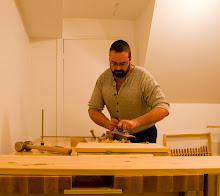Gentle readers, I have had an epiphany. It has to do with crowning plane blades, and names for planes.
I read an article by Adam Cherubini about the subject, and it resonated with me to such an extent that my ears are still ringing.
An archaeologist and historian named Henry Chapman Mercer wrote a book in 1929 called "Ancient Carpenter's Tools" wherein he decided to classify tools in order to give them 'true names', similar to the way biological nomenclature works. I liken it to genus and species. Using this analogy, the three genus of planes were set as levelling when the plane is used on a surface to make it flat and/or smooth, fitting when the plane is used on a surface no wider than its blade to create a new surface that will match another surface, and lastly ornamentation, which is where a plane is used strictly for a decorative effect.
Within each genus there are many possible species, but all share common traits. Yes, there are exceptions. There are always exceptions. However, here are some common traits:
Levelling planes like fore planes, smoothers, and try planes, have crowned irons and tight mouths. Exception - the fore plane has wider mouth as the surface finish isn't as important as speed.
Fitting planes like rabbet planes, match planes, plow planes, router planes, etc. have irons ground straight across and are used to produce the surfaces of joints. They have wide mouths because the surface won't be seen in the final product, so the surface finish isn't important. The exception is the jointer plane, which should have an iron ground straight across like other fitting planes, but it has a tight mouth because leaving a rough surface can be visible from the side when the joint is glued.
"But Mike!," I hear you exclaim, "the experts pretty much all use crowned irons in their jointer planes!"
Here's the interesting bit. Are you ready for this? Those aren't jointer planes. Those are try planes. Try planes are levelling planes, with a crowned iron. A jointer plane is used only for jointing edges for glue-up. Making a joint. That's it. It's a fitting plane.
Long has the nomenclature been rather... lax. Jack planes and fore planes are, in some books, the same, and in other books different. The same goes with try planes and jointers. I think Mercer was on to something.
I have a 'jack plane' which I use only for fitting, with a straight iron, so it is actually a short jointer.
I have a 'jointer plane' which I use for levelling, with a crowned iron, so it is actually a try plane.
I have a 'block plane' which I use for levelling, with a crowned iron, so it is actually a smoother.
It may seem complicated, but for me it has made things a whole lot clearer, and also clears up the reasons for some of the previous confusion. A wooden plane 24" long could be either a jointer or try plane depending on what you were going to use it for. Put a flat grind on it and it's a jointer. Put a camber on it and it's a try plane. If the plane didn't have an iron in it, then what kind of plane would it be?
The common jack plane, I suspect, was called such because you would have multiple blades for it and convert it from a short jointer to a fore plane to a short try plane on a whim.
Sunday, July 6, 2008
Subscribe to:
Post Comments (Atom)

No comments:
Post a Comment